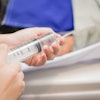Varying the dosage of low osmolality contrast media (LOCM) for routine abdominal CT based on patient size can provide optimized contrast delivery for a minimal cost increase, according to a multi-institutional study presented at the American Roentgen Ray Society meeting this month.
Interestingly, however, the perceived acceptability of such scans varied among the participating institutions.
"The purpose was to determine the lowest volume of LOCM that we could use in helical CT while still preserving clinically acceptable images," said Dr. Alec Megibow of New York University. "The endpoint of our study was 'Was the image acceptable and would (a radiologist) read it?' "
The group also took a look at the potential cost savings by using LOCM, he said. Six centers participated in the study, which was sponsored by Berlex Labs of Montvale, NJ.
A total of 436 patients participated at institutions including NYU, Duke University in Durham, NC, and Massachusetts General Hospital in Boston.
Patients were randomized into four groups based on their weight and the dosage of Ultravist 300 they received. Weight groups varied from less than 60 kg to greater than 100 kg. The dosage schedule ranged from 1.25 ml/kg to 2.0 ml/kg.
Following a single unenhanced image at L1-2, helical images were obtained from the superior liver through the inferior kidneys. The contrast was administered at 2.0 ml/sec and scanning began immediately afterward.
"We did a qualitative assessment by asking the radiologists at the various sites if the study was acceptable to them. We also did a quantitative assessment. A radiologist who was blinded to the data looked at the level of [Hounsfield unit] enhancement in the liver, aorta, pancreas, and kidneys over the non-contrast baseline," Megibow said.
According to the results, for doses greater than 1.5 ml/kg, 90% of the scans were acceptable to the readers. At doses over 1.5 ml/kg, liver enhancement was over 50 HU. However, there was a certain amount of disagreement over quality at the various sites.
"There were some centers that liked everything," Megibow said. "There was some centers that liked nothing. This is important because the individual site's expectations on what they want to see on a scan will determine what dosage you use."
Another interesting result was that the lightest patients who were given the lowest dose had the lowest numbers of acceptable scans, Megibow said. Historically, image artifacts are more of a problem when scanning larger patients.
"That's kind of paradoxical because you would think that (smaller patients) would have the most acceptable scans," he added. "I think this has to do with the overall aesthetic of looking at a pretty picture. The patients who are thin just don't have pretty scans."
In order to determine cost savings, two dosages were compared: the study dose of 1/5 ml/kg and a standard dosage of 100 ml, regardless of the patient's weight. For imaging 303 patients, weight-based dosage came to about $22,500. The price tag for the same number of patients who were given 100 ml was a little over $22,000.
"Weight-based dosing has no significant cost penalty and you can achieve an overall volume reduction in the amount of contrast agent that is used at your institution," Megibow said.
By Shalmali Pal
AuntMinnie.com staff writer
May 22, 2000
Let AuntMinnie.com know what you think about this story.
Copyright © 2000 AuntMinnie.com















